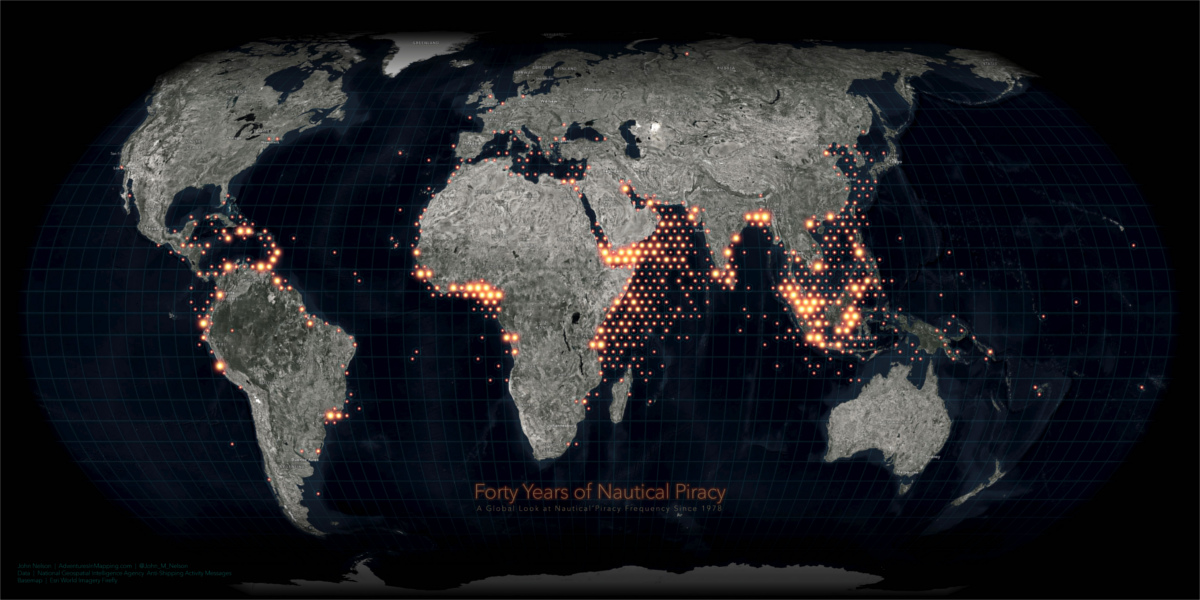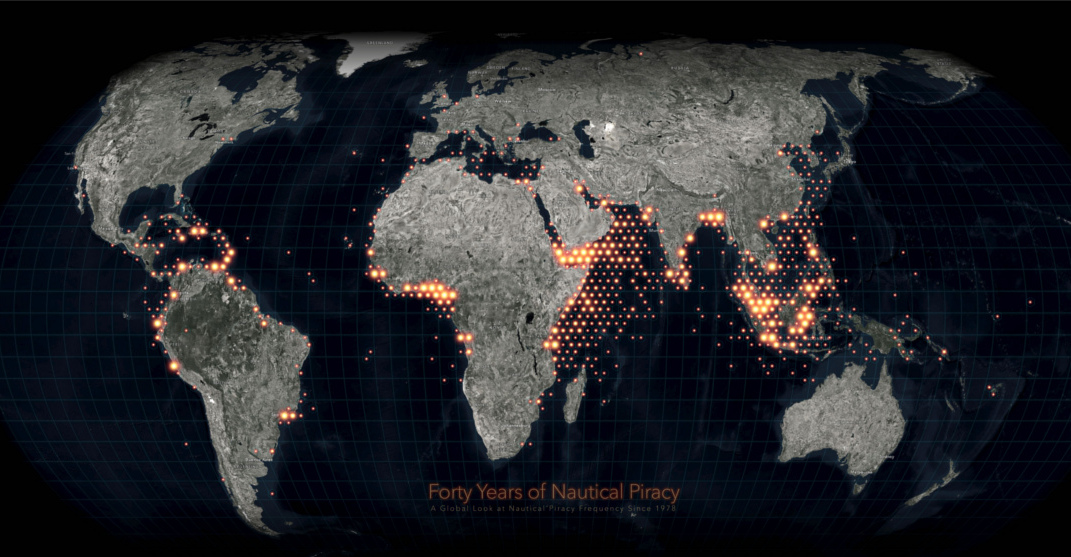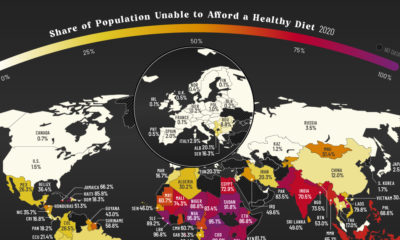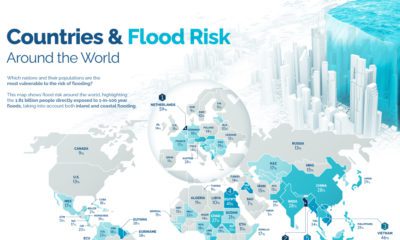Misc
Map: Visualizing 40 Years of Nautical Piracy
View the full-size version of the infographic
Map: Visualizing 40 Years of Nautical Piracy
View the full-size version of the infographic by clicking here
For millennia, voyaging on the open seas has been a dangerous and risky endeavor.
Between the powerful forces of Mother Nature and self-made obstacles stemming from human error, there is no shortage of possible calamities for even the bravest of sailors.
But for most of human history, perhaps the biggest fear that sailors grappled with was that of piracy. A run in with such marauders could lead to the theft of valuable cargo or even possible death, and it’s a threat that carries on even through modern times.
Hotbeds of Modern Piracy
Today’s map comes from Adventures in Mapping and it aggregates instances of piracy over the last 40 years based on the database from the National Geospatial-Intelligence Agency.
It should be noted that all individual events can be seen on this interactive map, which is what we will use to look at current hotbeds of piracy in more depth below.
1. The Strait of Malacca

The Strait of Malacca is one of the world’s most important shipping lanes, and also one of the most notorious.
A key chokepoint that sits between Malaysia and Indonesia, the Strait of Malacca is as narrow as 25 miles wide while also seeing a quarter of the world’s traded goods shipped through it every year. As a result, the strait and surrounding area are a frequent target for modern piracy.
Example account: (September 2002)
“The 1,699-ton Malaysian-flag tanker (NAUTICA KLUANG) was hijacked 28 Sep at 0300 local time while underway off Indonesia in the vicinity of Pulau Iyu Kecil at the southern tip of the Strait of Malacca. The pirates, armed with guns and machetes, tied up the crew and locked them in cabins. When the crew freed themselves at 0900, 29 Sep, the thieves had transferred the ship’s cargo of 3,000 tons of diesel oil, damaged communications equipment, and renamed it (CAKLU). ”
2. The Horn of Africa

When many people think of modern piracy, they think of the coast of Somalia. While those waters are often avoided, the nearby areas can be just as problematic.
In particular, the Bab el Mandeb strait, which connects the Red Sea to the Indian Ocean, is a target for modern piracy. Similarly, the waters just off of Yemen are quite treacherous as well.
Example account: (January 1991)
“Somali pirates attached MV Naviluck off Somalia, killing three Filipino crewmen and setting fire to the vessel. Three boatloads of armed Somali pirates boarded the vessel on 12 Jan 91 took the crew ashore and killed three of them. The captain said the vessel was attacked off Xaafuun while on her way from Mombasa to Jeddah. He declined to specify the cargo. The surviving crew were made to jump overboard, and were later rescued by M Stern TRLR Dubai Dolphin.”
3. The Gulf of Guinea
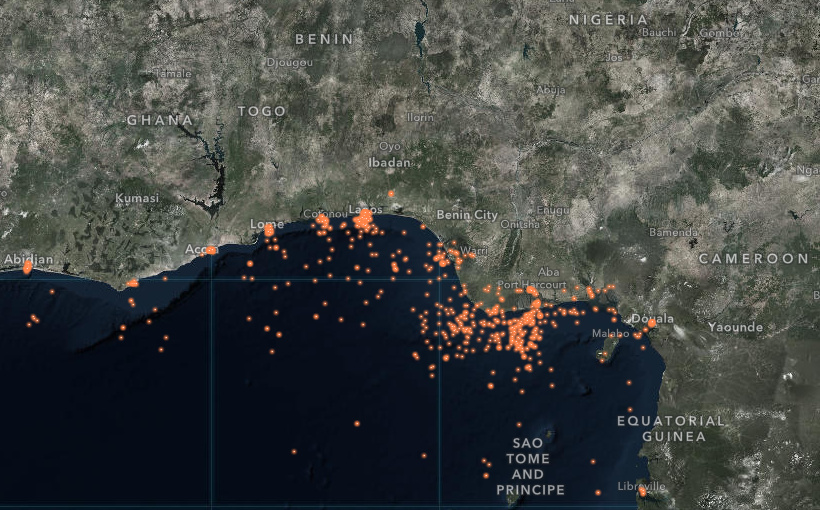
While we hear the most about Somalian pirates, the Gulf of Guinea that sits south of Nigeria, Benin, Togo, and Ghana in West Africa is also a well-known hotbed.
Tanker theft of petroleum products being shipped to and from Nigerian refineries is rampant, creating an ongoing concern for companies operating in the region.
Example account: (June 2013)
“On 13 June, the Singapore-flagged underway offshore supply vessel MDPL CONTINENTAL ONE was boarded and personnel kidnapped at 04-02N 008-02E, approximately 7 nm southwest of the OFON Oil Field. Two fiberglass speedboats, each with 2 outboards engines, each carrying 14 gunmen in wearing casual t-shirts and no masks, launched an attack. The pirates were armed with AK47’s. After stealing personal items and belongings, four expat crew were kidnapped (Polish Chief Engineer) and three Indians (Captain, Chief Officer, and Bosun).”
4. The Caribbean
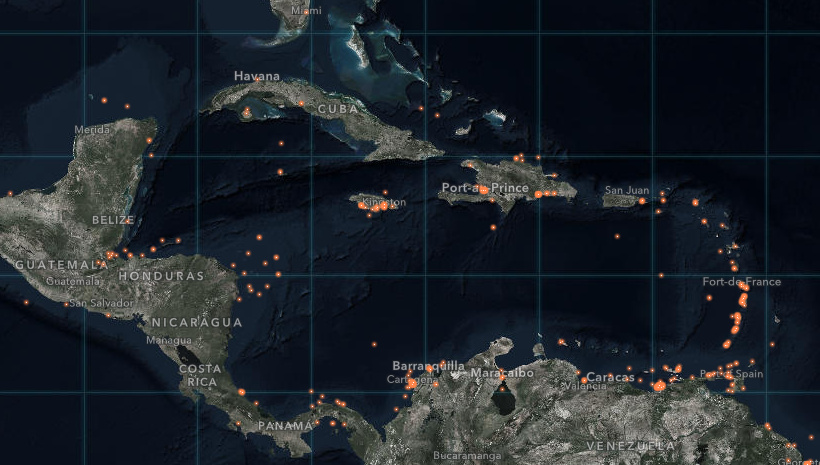
The Caribbean has a longstanding history with piracy – and while things have died down considerably since the peak, there are still isolated incidents that occur, especially with yachts.
Most incidents happen off the coast of Venezuela, or in and around the islands on the eastern side of the sea, such as Trinidad & Tobago, Barbados, and Grenada.
Example account: (March 2016)
“On 4 March, near position 13-16N 061-16W, several gunmen boarded a yacht anchored at Wallilabou in southwestern St. Vincent. During the course of the boarding, a German citizen aboard the yacht was killed and another person was injured. Authorities are investigating the incident.”
VC+
VC+: Get Our Key Takeaways From the IMF’s World Economic Outlook
A sneak preview of the exclusive VC+ Special Dispatch—your shortcut to understanding IMF’s World Economic Outlook report.

Have you read IMF’s latest World Economic Outlook yet? At a daunting 202 pages, we don’t blame you if it’s still on your to-do list.
But don’t worry, you don’t need to read the whole April release, because we’ve already done the hard work for you.
To save you time and effort, the Visual Capitalist team has compiled a visual analysis of everything you need to know from the report—and our VC+ Special Dispatch is available exclusively to VC+ members. All you need to do is log into the VC+ Archive.
If you’re not already subscribed to VC+, make sure you sign up now to access the full analysis of the IMF report, and more (we release similar deep dives every week).
For now, here’s what VC+ members get to see.
Your Shortcut to Understanding IMF’s World Economic Outlook
With long and short-term growth prospects declining for many countries around the world, this Special Dispatch offers a visual analysis of the key figures and takeaways from the IMF’s report including:
- The global decline in economic growth forecasts
- Real GDP growth and inflation forecasts for major nations in 2024
- When interest rate cuts will happen and interest rate forecasts
- How debt-to-GDP ratios have changed since 2000
- And much more!
Get the Full Breakdown in the Next VC+ Special Dispatch
VC+ members can access the full Special Dispatch by logging into the VC+ Archive, where you can also check out previous releases.
Make sure you join VC+ now to see exclusive charts and the full analysis of key takeaways from IMF’s World Economic Outlook.
Don’t miss out. Become a VC+ member today.
What You Get When You Become a VC+ Member
VC+ is Visual Capitalist’s premium subscription. As a member, you’ll get the following:
- Special Dispatches: Deep dive visual briefings on crucial reports and global trends
- Markets This Month: A snappy summary of the state of the markets and what to look out for
- The Trendline: Weekly curation of the best visualizations from across the globe
- Global Forecast Series: Our flagship annual report that covers everything you need to know related to the economy, markets, geopolitics, and the latest tech trends
- VC+ Archive: Hundreds of previously released VC+ briefings and reports that you’ve been missing out on, all in one dedicated hub
You can get all of the above, and more, by joining VC+ today.
-

 Debt1 week ago
Debt1 week agoHow Debt-to-GDP Ratios Have Changed Since 2000
-

 Markets2 weeks ago
Markets2 weeks agoRanked: The World’s Top Flight Routes, by Revenue
-

 Countries2 weeks ago
Countries2 weeks agoPopulation Projections: The World’s 6 Largest Countries in 2075
-

 Markets2 weeks ago
Markets2 weeks agoThe Top 10 States by Real GDP Growth in 2023
-

 Demographics2 weeks ago
Demographics2 weeks agoThe Smallest Gender Wage Gaps in OECD Countries
-

 United States2 weeks ago
United States2 weeks agoWhere U.S. Inflation Hit the Hardest in March 2024
-

 Green2 weeks ago
Green2 weeks agoTop Countries By Forest Growth Since 2001
-

 United States2 weeks ago
United States2 weeks agoRanked: The Largest U.S. Corporations by Number of Employees

